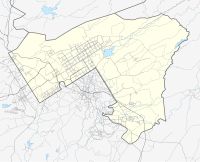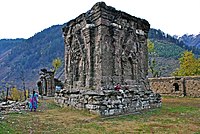
Islamabad is the capital city of the Islamic Republic of Pakistan. It is the country's ninth-most populous city with a population of over 1.2 million people and is federally administered by the Pakistani government as part of the Islamabad Capital Territory. Built as a planned city in the 1960s and established in 1967, it replaced Karachi as Pakistan's national capital.
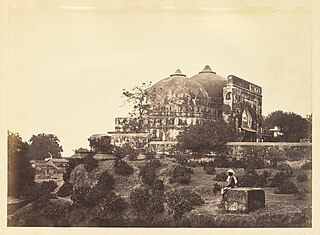
Babri Masjid was a mosque in Ayodhya, India. It has been claimed to have been built upon the site of Ram Janmabhoomi, the legendary birthplace of Rama, a principal deity of Hinduism. It has been a focus of dispute between the Hindu and Muslim communities since the 19th century. According to the mosque's inscriptions, it was built in 1528–29 by Mir Baqi, a commander of the Mughal emperor Babur. Before the 1940s, the masjid was officially known as "Masjid-i-Janmasthan". The mosque was attacked and demolished by a Hindu nationalist mob in 1992, which ignited communal violence across the Indian subcontinent.

Rawalpindi is the third-largest city in the Pakistani province of Punjab. It is a commercial and metropolitan city being the fourth most populous in previous census of 2017 in Pakistan. It is located near the Soan River in north-western Punjab, and is the third-largest Punjabi-speaking city in the world. Rawalpindi is situated close to Pakistan's capital Islamabad, and the two are jointly known as the "twin cities" because of the social and economic links between them.
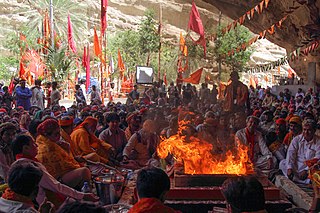
Hinduism is the second largest religious affiliation in Pakistan after Islam. Though Hinduism was one of the dominant faiths in the region a few centuries ago, Hindus accounted for just 2.14% of Pakistan's population in the 2017 Pakistani census. The Umerkot district has the highest percentage of Hindu residents in the country at 52.2%, while Tharparkar district has the most Hindus in absolute numbers at 714,698.

Murree Road, is a major road that runs from Islamabad and Rawalpindi to Murree in Pakistan. It passes through Rawalpindi's downtown area, and has been a hotspot for various political and social events.

The Margalla Hills are a hill range within the Margalla Hills National Park on the northern edge of Islamabad Capital Territory, Pakistan, just south of Haripur District, Khyber Pakhtunkhwa. They are part of the Himalayan foothills. The Margalla range has an area of 12,605 hectares. It is a range with many valleys as well as high mountains.

The Shri Katas Raj Temples, also known as Qila Katas, is a complex of several Hindu temples connected to one another by walkways. The temple complex surrounds a pond named Katas which is regarded as sacred by Hindus. The complex is located in the Potohar Plateau region of Pakistan's Punjab province. The temples are located in municipal committee Choa Saidanshah, and are near the M2 Motorway.

Tosham is a town and a Gram Panchayat on the foot of Tosham Hill range in Bhiwani district in the Indian state of Haryana. It has been awarded the title of "Adarsh Village". It is situated in the foothill of Tosham hill range of Aravali Mountain Range. The hill has several historic places, such as forts, carvings, paintings, temples, sacred ponds, dating as far back 1800 years. It is a rural area.
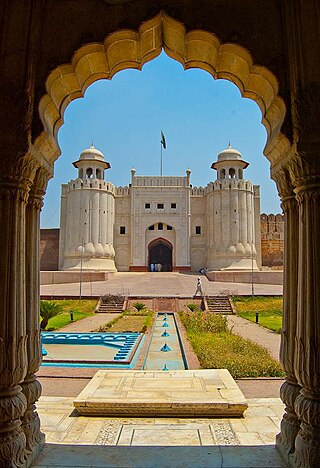
Tourism in Pakistan is a growing industry. In 2010, Lonely Planet termed Pakistan "tourism's 'next big thing'". The country is geographically and ethnically diverse, and has a number of historical and cultural heritage sites. Condé Nast Traveller ranked Pakistan The Best Holiday Destination for 2020 and also declared it the third-highest potential adventure destination in the world for 2020. As security in the country improves, tourism increases; in two years, it has increased by more than 300%.

In Hinduism, the yatra (pilgrimage) to the tirthas has special significance for earning the punya needed to attain the moksha (salvation) by performing the darśana, the parikrama (circumambulation), the yajna, the Dhyana, the puja (worship), the prarthana, the dakshina, the seva, the bhandara, etc. These sacred places are usually located on the banks of sacred waters, such as sacred rivers or their tributaries, the kundas, the ghats, or the stepwells, or the temple tanks.

Fatima Jinnah Park, also known as Capital Park or F-9 Park, is a public recreational park that spans the whole of Sector F-9 of Islamabad, Pakistan. It is named after Mādar-e Millat Fatima Jinnah, the younger sister of the founder of Pakistan Muhammad Ali Jinnah.

The Shri Swami Narayan Mandir, Karachi is a Hindu temple that is the only Swami Narayan temple in Pakistan. The temple is notable for its size and frontage, over 32,306 square yards (27,012 m2) on the M. A. Jinnah Road in Karachi city. The temple celebrated its anniversary of 216 years in April 2004. There is a sacred cowshed within the premises of this temple. The temple is located at the centre of a Hindu neighbourhood in Karachi. The building that housed a dharmshala for visiting devotees has now been converted to the office of the City District Government.
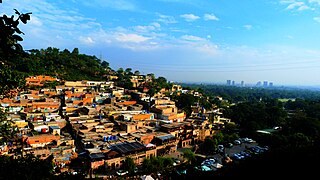
Saidpur is a village and union council (UC-1) located in a ravine in Pakistan in the Margalla Hills, near the Daman-e-Koh overlook, in the Islamabad Capital Territory. It is a Mughal Era village that has a wide spectrum of religious and cultural heritage. It serves as a tourist spot for locals as well as foreigners.

Shah Allah Ditta is a centuries-old village and a union council located at the foothills of the Margalla Hills in the Islamabad Capital Territory, Pakistan. It s located adjacent to Sector D-12 of Islamabad.

Ayub National Park, commonly known as Ayub Park or, historically, Topi Rakh Park, is a national park located on the Grand Trunk Road, not far away from the old presidency in Rawalpindi, Punjab, Pakistan.

Rajgan Mosque is a historic mosque located in Khanpur, Khyber Pakhtunkhwa, Pakistan. It is located at the northern edge of the Khanpur Dam reservoir. It is locally known as ‘Rajon ki Masjid’, and is usually deserted except for Eid congregations. It is a 90-minute drive away from Islamabad.

The Rama Pir Mandir is a Hindu temple dedicated to Ramdev Pir in Tando Allahyar in Sindh, Pakistan. The annual Ramapir Mela festival is the second largest Hindu pilgrimage in Pakistan, after the annual Hinglaj yatra, which is the largest Hindu pilgrimage in Pakistan.
Shri Krishna Mandir, still under construction, is the first Hindu temple to be granted permission to be built in Islamabad, capital of Pakistan, on 0.5 acre land in the H-9 area of Islamabad Capital Territory. It will be a place of worship for the 3,000 Hindu families living in Islamabad. The temple will be managed by the Pakistan Hindu Panchayat. The construction of the temple is controversial: since the approval the construction was challenged by many Islamic extremists and the construction site has been attacked and vandalised four times.

The Shri Krishna mandir, or the Krishna Temple, is a Hindu temple located in Rawalpindi in the Punjab province of Pakistan. It is situated between the Rawalpindi railway station and Kabari Bazaar in Saddar. Currently, it is one of the two places of worship for the approximately 7,000 Hindus living in Rawalpindi and Islamabad, with the other handful of temples being non-functional. Hindu festivals like Holi and Diwali are celebrated here.

